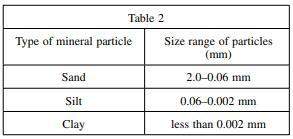
Chemistry, 08.10.2019 00:20 angiepuma43
Students in a science class collected soil samples from various locations in order to analyze the composition of the soil. they measured the percentage of the three types of soil minerals—sand, silt, and clay—in each sample. their data is presented in table 1. the students also measured the size of the mineral particles found in the soil samples. the particle size ranges are listed in table 2.
which soil sample is most likely to have an average mineral particle size of 1.3 millimeters?
question 3 options:
sample 4
sample 5
sample 3
sample 2
the students collected a sixth soil sample from a location near the location from which they collected sample 4. based on information in the passage, this sixth sample would contain mineral particles that were predominantly:
question 4 options:
smaller than 0.06 mm
smaller than 0.002 mm
larger than 0.06 mm
larger than 2.0 mm
sample 2 would most likely, if measured, have an average mineral particle size of:
question 5 options:
0.001 mm
0.06 mm
1.0 mm
1.5 mm



Answers: 2
Another question on Chemistry

Chemistry, 22.06.2019 10:00
Suppose the universe were completely empty except for one object-a solid sphere moving through space of 100 km/s. what sort of path would the object be moving in? explain your answer
Answers: 1

Chemistry, 22.06.2019 14:30
For the reaction shown, find the limiting reactant for each of the following initial amounts of reactants. 4al(s)+3o2(g)→2al2o3(s) a) 1 molal, 1 mol o2 b) 4 molal, 2.6 mol o2 c) 16 molal, 13 mol o2 d) 7.4 molal, 6.5 mol o2
Answers: 3

Chemistry, 23.06.2019 00:30
What are the advantages of using the metric system? designed as a decimal system making conversions simpler more accurate system of measurement has prefixes that correspond to an amount to use with all base units used by the entire scientific community
Answers: 2

Chemistry, 23.06.2019 02:00
To calculate the molarity of a solution, you need to know the moles of solute and the
Answers: 2
You know the right answer?
Students in a science class collected soil samples from various locations in order to analyze the co...
Questions



Computers and Technology, 10.03.2020 23:18


History, 10.03.2020 23:19











Mathematics, 10.03.2020 23:20

Mathematics, 10.03.2020 23:20

History, 10.03.2020 23:20


Chemistry, 10.03.2020 23:20



